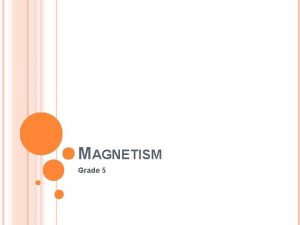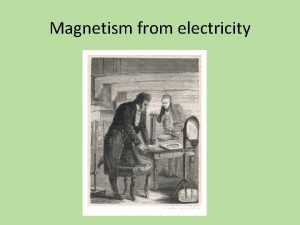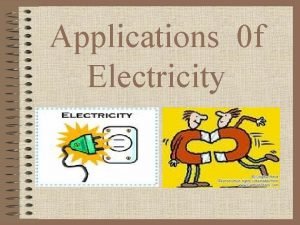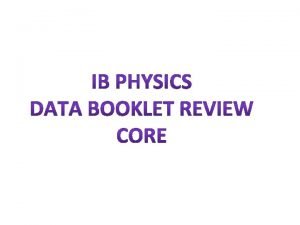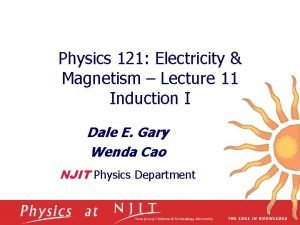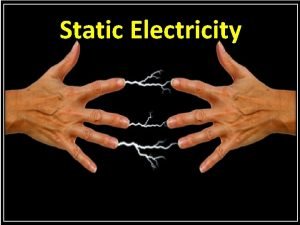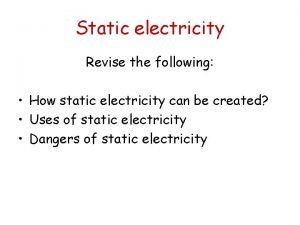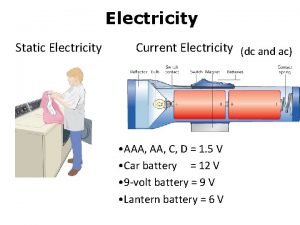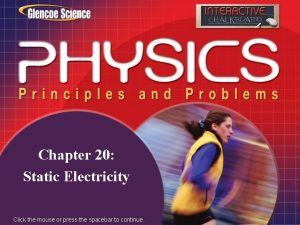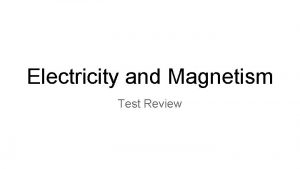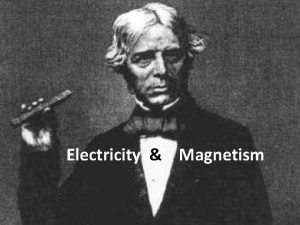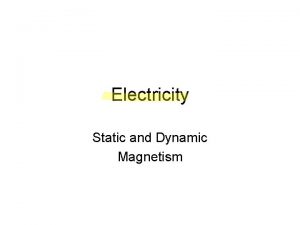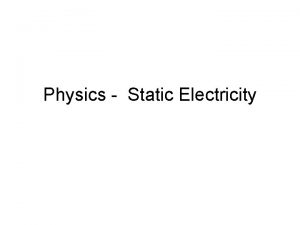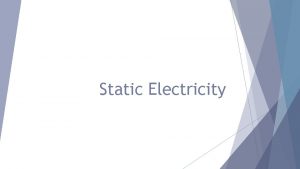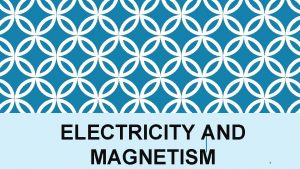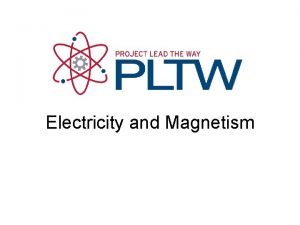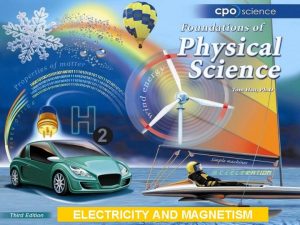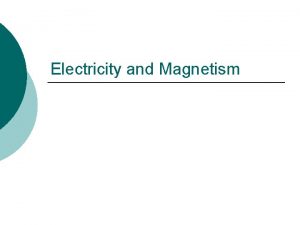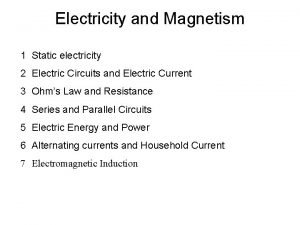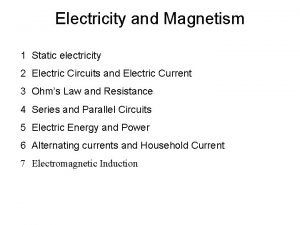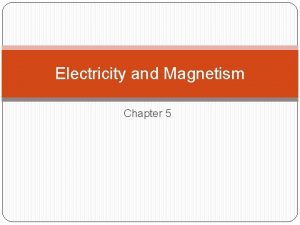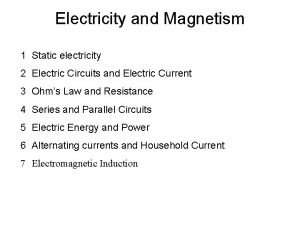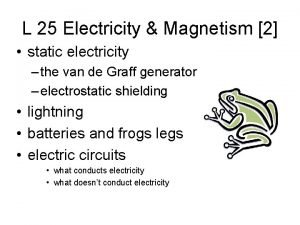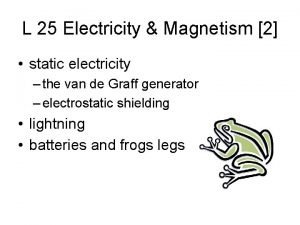Static Electricity Test on Electricity and Magnetism on























- Slides: 23

Static Electricity Test on Electricity and Magnetism on Feb 20 and Feb 21

Electric Charges • Negative charge comes from extra electrons • Positive charge comes from lack of electrons • Law of Conservation of Electric Charge – Net amount of charge produced is zero. • Like charges repel • Opposite charges attract • Charge can be transferred from one object to another • e = charge of one electron = 1. 602 x 10 -19 C

Insulators and Conductors • Conductors allow electrons to pass through them • Insulators prevent electrons from passing through them • Semi-conductors have characteristics of both • Free Electrons

Conduction • When a charged object touches a conductor, some of the charge will be transferred to the conductor. Now both objects will have the same charge and the objects will be repelled. • This charging is permanent. • When the charged object is removed, both objects will retain their charge.

Induction • A charged object is brought close to a conductor without touching it. The charges inside the conductor separate so that likes repel and opposites attract. The objects will be attracted to each other. • This charging is only temporary. • When the charged object is removed, the conductor returns to normal.

The Electroscope • Homework – research and build an electroscope. Make sure you know how it works and what is happening inside of it. Bring it to class in on Friday

Electric Force • Every electric charge produces a field force that attracts or repels other charges. • The electric force obeys the inverse square law. • The force of attraction/repulsion between charges is called Coulumb’s Law F = k. Q 1 Q 2/r 2 • k = 9 x 109 Nm 2/C 2

Electric Force • This equation applies for point charges only, • And only for objects at rest. • If there are two charges, the force on charge A is equal to the force on charge B. • If there are more than two charges, then the forces add together.

How do you feel about some… Examples? !

Electric Field • The electric force is a field force (force that can act without touching) therefore it generates a field around it. Anything that comes into the field will feel its force. • Every charged particle creates its own electric field and multiple fields may exist. • The field obeys the inverse square law. E = k. Q/r 2 = F/Q 2

How do you feel about some more… Examples? !

Electric Field • The electric field can be shown by drawing lines that show the direction a positively charged particle would travel. • The electric field and electric force are vectors so they can be added together. Pay attention to sign.

Electric Fields • Dipoles

Electric Field Lines • The field lines indicate the direction of the electric field • The lines are drawn so that the magnitude of the field is proportional to the number of lines drawn. Closer lines = stronger field • Electric field lines start on positive charges and end on negative ones. The # starting or ending is pro. to the mag. of the charge

Electric Fields • Strength of Field

Conductors in a Field • The electric field inside a conductor is zero. • The electric field is always perpendicular to the surface outside of a conductor.

Parallel Plates • This setup creates a scenario similar to gravity. • A charged particle moving through this setup would feel a pull (+ downward, - upward) • The result is a projectile motion problem with electric force instead of gravity. • F = ma • q. E = ma a = q. E/m

Electric Potential • Conservation of energy • Electric potential – Potential energy per unit charge • Parallel plates • Work-Energy Theorem – The amount of work required to move a charge in an electric field is equal to a change in the kinetic (or potential) energy

Electric Potential • The work done to move that charge depends on the magnitude of that charge. • Positive work is in the direction of motion. Negative work is done in the direction opposite motion. • Electric Potential (V) • V = PE/q • PEelectric = k. Q 1 Q 2/r • V = kq/r

Electric Potential Difference • The difference in electric potential as you move from point A to point B • Measured in volts • V= - Work/q = ΔPE/q • Electric Potential Difference is like Gravitational Potential Energy in the sense that you may choose a place where the electric potential is zero to make calculations easier.

Electric Potential and Electric Field • Vba = Ed • Places where the electric potential are the same are shown by equipotential lines • Drawn perpendicular to the electric field lines

Capacitors • Device that can store electric charge • Consists of two conducting surfaces not in contact • One surface acquires a positive charge, the other surface acquires a negative charge • Eventually the surfaces will become “full” and charge will leak. • A dielectric separates the two surfaces

Capacitors • Parallel Plate Capacitors • C = capacitance C = ε 0 A/d • ε 0= 1/4πk
 Static electricity and current electricity
Static electricity and current electricity Current electricity gif
Current electricity gif Magnetism vocabulary
Magnetism vocabulary 4 forces of nature
4 forces of nature Ib physics topic 5
Ib physics topic 5 Electricity and magnetism lecture notes
Electricity and magnetism lecture notes Electricity and magnetism jeopardy
Electricity and magnetism jeopardy Sph3u electricity and magnetism
Sph3u electricity and magnetism Electromagnet experiment hypothesis
Electromagnet experiment hypothesis Induced magnetic moment
Induced magnetic moment Magnetism grade 5
Magnetism grade 5 Electricity and magnetism
Electricity and magnetism Electricity and magnetism
Electricity and magnetism Ampere
Ampere Electricity and magnetism
Electricity and magnetism Electricity and magnetism
Electricity and magnetism Difference between charge and electric charge
Difference between charge and electric charge Renaldo and nasreen build an electromagnet
Renaldo and nasreen build an electromagnet What is static electricity
What is static electricity How does a photocopier work using static electricity
How does a photocopier work using static electricity Bill nye friction worksheet
Bill nye friction worksheet What is electricity made of
What is electricity made of Electric current
Electric current Static electricity chapter 20 answers
Static electricity chapter 20 answers










